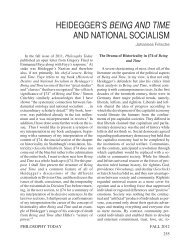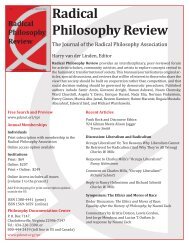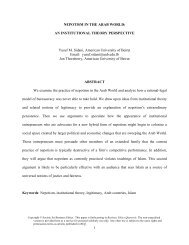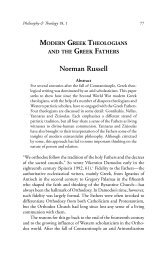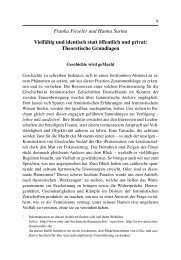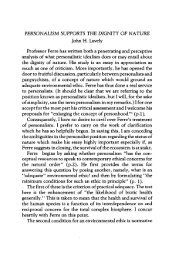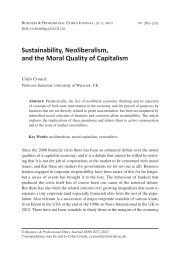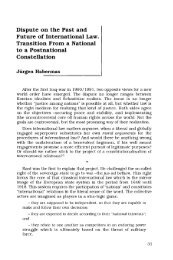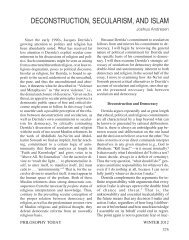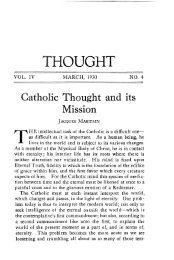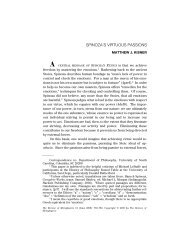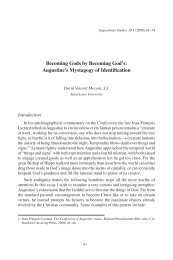What is Moral Action?* - Philosophy Documentation Center
What is Moral Action?* - Philosophy Documentation Center
What is Moral Action?* - Philosophy Documentation Center
Create successful ePaper yourself
Turn your PDF publications into a flip-book with our unique Google optimized e-Paper software.
<strong>What</strong> <strong>is</strong> <strong>Moral</strong> <strong>Action</strong>? *<br />
by Robert Sokolo'lJ'ski<br />
"He <strong>is</strong> devoted to YOll in h<strong>is</strong>' way,"<br />
said M<strong>is</strong>s Ridley.<br />
"I daresay a cat does the right thing<br />
to a mouse in its way."<br />
"Doing things in your own way <strong>is</strong> not<br />
really doing them," said Megan.<br />
-I. Compton-Burnett, The Present and<br />
the Paste<br />
I<br />
WISH 1'0 CLARIFY, philosophieally, what a moral aeo<br />
tion <strong>is</strong>. The best way to proceed in th<strong>is</strong> venture would be<br />
to exhibita moral performance and to reflect on it. <strong>What</strong> I<br />
have to say could be said much more effectively if I were able<br />
to comment on something that OCCllrs publicly before me and<br />
my audience, that <strong>is</strong>, if I could do more than speak in general<br />
and in the abstract.<br />
But as· I prep'are th<strong>is</strong> lecture, I know that I cannot count<br />
on a moral exchange happening just when I alU to deliver the<br />
lecture. It <strong>is</strong> most unlikely that at prec<strong>is</strong>ely that moment-at<br />
* An earlier version of th<strong>is</strong> paper was presented as the Suarez Lecture<br />
at Fordham University on April 2, 1987. In having the paper publ<strong>is</strong>hed<br />
I w<strong>is</strong>h to retain the form it had as a lecture be,cause I think the centrality<br />
of actual performances in moral philosophy can be better expressed<br />
in that way, and also because the change from a spoken to a written form<br />
can occasion an interesting study of perspectival, hermenetutical shifts,<br />
as I try to show in fn 1. The paper pre,sents the theory of moral conduct<br />
that I developed ,at greater length in my book, <strong>Moral</strong> <strong>Action</strong>. A PhenomenologicaZ<br />
Study (Bloomington: Indiana University Press, 1985), and<br />
in two essays: "<strong>Moral</strong> Thinking," to appear in a collection entitled<br />
Husserl and the Phenomenological Tradition, edited by Robert Sokolowski<br />
(Washington, D.C.: The Catholic University of America Press, forthcoming),<br />
and "Knowing Natural Law," Tijdschrift voor Fil(Jsojie, 43<br />
(1981), pp. 625-641.<br />
18
"fVhat <strong>is</strong> ];[oral <strong>Action</strong>? 19<br />
th<strong>is</strong> moment now, while I read these words to you-some moral<br />
performance would be transacted in the full view and with th~<br />
full understanding of my audienee and me: some act of eunning<br />
revenge 01' tactful gratitude, of tender benevolence or<br />
furious insult. N 0, it would be too much to ask fortune to place<br />
such an example beiore us at the exact moment it <strong>is</strong> desired. 1<br />
I have no alternative but to take the <strong>is</strong>sue in hand myself<br />
and, by my own efforts, to bring an example to my mind and<br />
yours. I cannot do th<strong>is</strong> by doing sonlething moral myself, since<br />
I am to be engaged in a situation that requires only that I<br />
speak, not that I act. Furthermore there will, most likely, be<br />
nothing in the situation in which I speak that will call for an<br />
action, and without the appropriate setting no action <strong>is</strong> possible.<br />
Anything that I might do as a contrived performance<br />
would· be a p,retense at action, not a genuine deed. N 01' ean I<br />
depict an action to you in its concreteness by presenting a<br />
1 Temporal horizons shift in interesting ways when I change from (1)<br />
preparing these remarks for delivery in a lecture, to (2) actually stating<br />
them before an audience, to (3) preparing them for an essay to be<br />
(4) interpreted by readers. The hermeneutic contexts become radically<br />
different ,and the "now" changes in the four situations. I ,vas alone as<br />
I originally (" now1 ") ,vrote the words, but when I lectured, land my<br />
audience were together in a single context (" now2 "). I became a public<br />
presence. Furthermore, because I was there as the speaker, I could react<br />
to the situation and couId modif~T what I said in order to adapt it to<br />
what was going on. I was able to oontrol the interpretation to some<br />
degree. But when I "now3" aa a writer use the same ,vords I once prepared<br />
für an audience, those same ,vords that I once spoke to an audience,<br />
I return to solitude, and I know that you at some time (" now4. ",<br />
while you are reading) will also be aIone as you achieve your interpretation.<br />
I cannot be there to accommodate my words to your context. At<br />
that time ,ve will he bodily separated, but united in the achievement of<br />
one and the same meaning, interpreted through all these contexts. You<br />
will appreciate what you read as the same as what I once declared<br />
before a group of l<strong>is</strong>teners, and you will even see through the speechsituation<br />
to the time (" now1") when I first wrote the lecture. The<br />
speech-situation, which was once the final, actual context, becomes relativized<br />
and profiled within new contexts, the contexts of the variouB<br />
readers, who will be in many different places. The various "nows"<br />
become nested within one another.
20 Robert Sokolowsk·i<br />
drama or runninga film, since the time needed to establ<strong>is</strong>h the<br />
characters, set the circumstances, and stage the transaction<br />
would leave us with no time to philosophize about what has<br />
taken place. We would be engrossed by the enactment and<br />
would have to forego thinking about it.<br />
If I am to bring a concrete action before you, I ean do so<br />
only by talking about one, by describing one. And th<strong>is</strong> of<br />
course <strong>is</strong> to bring the action before YOll in its ahsence. Afew<br />
words will have to suffice to establ<strong>is</strong>h th.e characters and set<br />
the circumstances, a few more words to describe the action itself.<br />
<strong>What</strong> I have to say will be no more than a simple pencil<br />
drawing, a few lines that seem as nothing whether comp-ared<br />
to the staged depiction or to the bodily presence of the event.<br />
Much has to be left to your imagination.<br />
Ralph <strong>is</strong> a hachelor. Conflicts at h<strong>is</strong> job have worn him<br />
down. He has lost h<strong>is</strong> nerve, he <strong>is</strong> ill and depressed. He happens<br />
to have an appointment with Norman, h<strong>is</strong> dent<strong>is</strong>t and<br />
friend, who asks hirn ahout the general state of h<strong>is</strong> health and<br />
soon hears the whole story of Ralph's ordeal. N orman soon<br />
realizes that much of Ralph's d<strong>is</strong>tress sterns from loneliness,<br />
from the piressure of living alone at a time when he needs help-.<br />
He suggests that Ralph come to live for a while with hirn and<br />
h<strong>is</strong> family. Ralp-h does so. He lives with them for a month,<br />
and with their help he <strong>is</strong> much hetter ahle to deal with h<strong>is</strong> conflicts<br />
at work and with h<strong>is</strong>. other problems. H<strong>is</strong> life <strong>is</strong> p-ut on a<br />
steadier course.<br />
<strong>What</strong> N orman and h<strong>is</strong> family did was a moral transaction.<br />
Ralph <strong>is</strong> grat.eful for what was done, and gratitude <strong>is</strong> the response<br />
to henevolence. Gratitude <strong>is</strong>, we might say, the appropriate<br />
perception of benevolence. It <strong>is</strong> the way the target of<br />
the benevolence, the beneficiary, recognizes \vhat has heen done.<br />
Ralph's gratitude <strong>is</strong> a kind of warrant for us that a moral performance<br />
has occurred.<br />
But what makes N orman's action to be a moral action ~ <strong>What</strong>
<strong>What</strong> <strong>is</strong> <strong>Moral</strong> <strong>Action</strong>? 21<br />
makes it different from an action without moral quality ~ Suppose<br />
that Ralph had rented a room in a boarding house and<br />
through the conviviality of the other boarders managed to get<br />
over h<strong>is</strong> nervous <strong>is</strong>olation. The owner of the house, in renting<br />
Ralph the room, did not become engaged in a moral transa.ction.<br />
Ralph would consider himself lucky that he moved into the<br />
house, hut strictly speaking hewould not he morally grateful<br />
to the man who rented the room to him. There would be no<br />
change in the moral relationship hetween Ralph and the owner,<br />
but there <strong>is</strong> a change in the relationship hetween Ralph and<br />
Norman because of what was done. <strong>What</strong> accounts for th<strong>is</strong><br />
difference? <strong>What</strong> <strong>is</strong> there in a moral exchange that <strong>is</strong> not<br />
found in other human exchanges ?<br />
Before trying to answer th<strong>is</strong> question, let us observe that<br />
henevolent actions, 01'" what we could call good moral actions,<br />
are not the only kind we must d<strong>is</strong>cuss. A malevolent transaction<br />
<strong>is</strong> a moral action too. A moral action can be morally good<br />
or morally bad. The special difference that constitutes a moral<br />
act as moral must he able to account for both the good and the<br />
bad. <strong>What</strong> we are looking for <strong>is</strong> what p,uts human behavior<br />
into the domain of morals as such. We w<strong>is</strong>h' to determine what<br />
places a human action into the " game " of morals, whether the<br />
action he judged to he good or had.<br />
l will therefore sketch in words another moral exchange besides<br />
the one that occurred hetween Ralp,h and Norman. Let<br />
us add a concrete instance of maIeficence to the henevolence we<br />
have described.<br />
Sidney <strong>is</strong> working hard for advancement in h<strong>is</strong> career. Just<br />
when the crucial promotion <strong>is</strong> within h<strong>is</strong> reach, just as he ia<br />
about to get what he has, always wanted, Arthur reveals<br />
Sidney's secret. It was something that was done a long time<br />
ago, something of which Sidney has often repented. He lived<br />
in fea1'" that it vvould s:omeday hecome known. Arthur learned<br />
ahout the secret through the long-'standing rivalry between their
22 Robert Sokolowski<br />
respective families, and just at the right moment, at the time<br />
when it would do the most devastating and irreparable dam.<br />
age, Arthur reveals the secret to the local gossip, who by the<br />
very inclination of h<strong>is</strong> nature quickly makes it known to every<br />
Olle. Sidney's career <strong>is</strong> destroyed.<br />
<strong>What</strong> makes th<strong>is</strong> to be a moral exchange? Why does Sidney<br />
hear resentment toward Arthur, and why have he and Arthur<br />
been establ<strong>is</strong>hed, by the action, as morally related, as offended<br />
and offender <strong>What</strong> makes, th<strong>is</strong> case different from one in<br />
which, say, a clerk happens to d<strong>is</strong>cover and reveal the damaging<br />
information during a routine check? If only th<strong>is</strong> had happened,<br />
the effect on Sidney's career might weIl have been the<br />
same; h<strong>is</strong> career might weIl have been just as' dec<strong>is</strong>ively destroyed.<br />
Sidney would then have considered himself unlucky,<br />
but he would not have been henceforth morally 1"elated to the<br />
clerk ,as the one offended to the offender, nor would he hear 1"esentmen.t<br />
toward the clerk. In fact, even in the exchange between<br />
Sidney and Arthur, Sidney does not bear the same 1"esentment,<br />
the s.ame moral response, toward the gossip as he<br />
does toward Arthur, who "did" something to him more explicitly<br />
than the gossip did. <strong>What</strong> makes th<strong>is</strong> action moral?<br />
A moral action <strong>is</strong> constitutedas such by a special identificational<br />
form. An action <strong>is</strong> a mora,l action because it <strong>is</strong>o identified<br />
by the agent in a special way. A particular human performance<br />
<strong>is</strong> establ<strong>is</strong>hed as, gay, a henevolent action, because what <strong>is</strong><br />
done <strong>is</strong> ap'preciated, by·the agent, as good for someone else, and<br />
it <strong>is</strong> wanted and accompl<strong>is</strong>hed prec<strong>is</strong>ely as good for that other<br />
person. NormaIi ap'preciates company and conversation here<br />
and now as good for Ralph; he knows, that Ralph needs th<strong>is</strong><br />
and that it will be good for hinl; and he wants and accompl<strong>is</strong>.hes<br />
it prec<strong>is</strong>ely as good for hirn. As good for Ralph, it becornes<br />
good for Norman. It <strong>is</strong> because of th<strong>is</strong> identificational form<br />
that the behavior becomesa moral transaction and does not<br />
remain a morally indifferent exchange. It <strong>is</strong> hecause Norman
<strong>What</strong> <strong>is</strong> <strong>Moral</strong> <strong>Action</strong>? 23<br />
,vanted and did sOluething as good for Ralph, that 'Ralph 00<br />
comes constituted as a beneficiary and responds with gratitude.<br />
An analogous recognitional form establ<strong>is</strong>hes a performance<br />
as a malevolent moral action. Arthur appreciates the d<strong>is</strong>closure<br />
of Sidney's secret as bad for Sidney, as dreadfully bad for<br />
him. And Arthur wants and accompl<strong>is</strong>hes th<strong>is</strong> event prec<strong>is</strong>ely<br />
as bad for Sidney. As bad for Sidney, it becomes Arthur's<br />
good. Beca.use of th<strong>is</strong> recognitional form, a moral transaction,<br />
an act ofcruelty or of revenge, has been enacted between<br />
Arthur and Sidney.<br />
Let U8 state th<strong>is</strong> more formally. A performance becomes a<br />
moral performance when it becomes wanted and done, or unwanted<br />
und averted, prec<strong>is</strong>ely as good or bad for the ta.rget of<br />
theaction. As good or bad for· the target, it becomes good or<br />
bad for the agent. It <strong>is</strong> th<strong>is</strong> identificational form, th<strong>is</strong> categoriality,<br />
th<strong>is</strong> thoughtful recognition, th<strong>is</strong> style of " taking ...<br />
as ...," that changes a bodily performance into a moral transaction.<br />
The identificational form changes a handing over into<br />
a generous giving, it changesa shove into an insult, it changes<br />
an act of feeding someone in a restaurant into an expression of<br />
gratitude, it changes denting someone's car into a mean-spirited<br />
act of revenge. Adapting a word llsed by Husserl, I would like<br />
to introduce the term" moral categoriality " to name th<strong>is</strong> recognitional<br />
form, the form that constitutes a moral transaction. 2<br />
By categoriality HUBserl meaIlS the formal articulation we<br />
achieve in an object "\vhen we let the various parts of the object<br />
be differentiated and recognized as parts. In a perception, for<br />
example, we might first simply seea shiny, whit<strong>is</strong>h patch;<br />
then we may reg<strong>is</strong>ter the patch a8 ice; then we may take the<br />
ice as slippery and dangerous. The simple, precategorial sensi-<br />
2 On Husserl's notion of categorial form, see my essay, "Husserl's Concept<br />
of Gategorial Intuition," Phenomenology and the Human 8ciences,<br />
Supplement to Philosophical Topics, 12 (1981), pp. 127-141. On the appUcation<br />
of categoriality to <strong>Moral</strong>s, see MoraZ <strong>Action</strong>, pp. 1-6.
24 Robert Sokolowslci<br />
bility of a shiny white patch hecomes articulated into a categorial<br />
object, one that we might express as, "Th<strong>is</strong> slippery<br />
patch of ice <strong>is</strong> dangerous." A categorial object <strong>is</strong> an object infected<br />
with syntax, and the categoriality of the ohject lies in<br />
the syntactic form the object takes on.<br />
There <strong>is</strong> a categoriality proper to moral thinking and moral<br />
conduct. It <strong>is</strong> the form of someone else's good or bad being<br />
taken, and done, as my own good or bad. In th<strong>is</strong> categorial<br />
form the various parts of the good, and the various slants the<br />
goodpresents, are articulated al1d reg<strong>is</strong>tered. Such moral<br />
categoriality <strong>is</strong> specifically human. It <strong>is</strong> also a rational accompl<strong>is</strong>hment.<br />
It <strong>is</strong> the introduction of moral thinking into human<br />
desires and aversions. Whenwe become capable of exerc<strong>is</strong>ing<br />
such moral categoriality, we become establ<strong>is</strong>hedas moral<br />
agents. Th<strong>is</strong> moral form, th<strong>is</strong> categorial identification <strong>is</strong> what<br />
opens up the logical space in which terms such as resentment<br />
and gratitude, pity and pardon, indignation and forgivene.ss,<br />
blame and pra<strong>is</strong>e, and other terms that express moral uptake<br />
acquire their meaning. Th<strong>is</strong> identification form puts us into<br />
the domain of morals.<br />
Various objections tomy analys<strong>is</strong> come to mind. One objection<br />
might be formulated as folIows: "Arthur injured Sidney<br />
by revealing h<strong>is</strong> secret. But surely the reason why the revelation<br />
was a moral transaction lies not in any complicated form.<br />
such as you describe, not in any categoriality, but rather in the<br />
fact that Arthur freely decided to reveal the secret. It was an<br />
act of Arthur's will, adec<strong>is</strong>ion, that made h<strong>is</strong> performance<br />
moral. H<strong>is</strong> act of free choice, together with the intention he<br />
had at the time, made the revelation to be not merely an unlucky<br />
accident but a moral transaction."<br />
But th<strong>is</strong> objection m<strong>is</strong>places the central and primary accompl<strong>is</strong>hment<br />
in moral action. It assumes that the substance of<br />
a moral performance lies in adec<strong>is</strong>ion that precedes the pu}}.<br />
lic behavior. The p'ublic behavior, in th<strong>is</strong> understanding,
lVha.t i,s JJ!f.oral <strong>Action</strong>,? 25<br />
would only <strong>is</strong>su.e from the aet of the will; the public behavior<br />
would 1e the outcome of a choice. But in fact the substance of<br />
the moral action <strong>is</strong> in the performance itself. Sidney <strong>is</strong> injured<br />
when the secret <strong>is</strong> revealed. The public event <strong>is</strong> what<br />
changes the moral relationship hetween Sidney and Arthur.<br />
Arthur may have made up h<strong>is</strong> milld at an earlier time to reo.<br />
veal the secret, but th<strong>is</strong> making up of h<strong>is</strong> mind <strong>is</strong> only a kind<br />
of anticipation of the deed. We should understand the dec<strong>is</strong>ion<br />
in relation to the performal1ce, not the performance in relation<br />
to its anticipation.<br />
To place the substance of a moral action in the internal act<br />
of the will <strong>is</strong> to etiolate the moral action, to make it far too<br />
much a private ep<strong>is</strong>ode rather than a transformation or rearrangement<br />
of the way things are in the world. There are such<br />
things as dec<strong>is</strong>ion, und we do sometimes make up our minds<br />
to act before we perform, but such thoughtful changes in us<br />
must not he seen as ends in themselves; they are the beginnings<br />
which end in puhlic performances, they are anticipations<br />
of morally formed behavior, the initial stirrings of action.<br />
They are faint ineeptions and not the climax of action. They<br />
are the empty intendings of which the actions themselves are<br />
the fulfillments.<br />
The suhstance of a moral transaction liesr therefore not in<br />
a thought or in an intention or in an act of willing, but in<br />
thoughtful behavior, in an embodied performance which, as<br />
good or as bad for another, <strong>is</strong> done or averted as the agent's<br />
good or bad. It <strong>is</strong> the thoughtful fornl that makes the performance<br />
moral, hut of course the form needs the performance as its<br />
embodiment and exp,ression.<br />
The form of a moral transaction can be realized in innumerable<br />
ways,and there are countless variations and nuances in<br />
the manner in which I e:an take your good or· bad, as such, as<br />
my own good or had. Let us mention a few examples from<br />
Shakespeare : Iago's. fanning of Othello's sU8picion; Edgar's
26<br />
protection of h<strong>is</strong> blinded father Gloucester; Maria's deception<br />
and humiliation of Malvolio; Macbeth's slaughter of Macduff's<br />
wife and children; the shepherd's preservation of Perdita;<br />
even Hamlet's refusal to kill Claudius while he <strong>is</strong> praying<br />
(Claudius' good, the salvation of h<strong>is</strong> soul, <strong>is</strong> taken as Hamlet's<br />
bad and <strong>is</strong> averted) ; so much variety of performance, so many<br />
vivid transactions, yet in 'all of them the same formal pattern,<br />
with the agent taking the good or the bad of h<strong>is</strong> target as h<strong>is</strong><br />
own good or had. And moral actions, constituted by th<strong>is</strong> form,<br />
do not occur only as momentous actions that are worthy of 00<br />
ing d<strong>is</strong>played in a drama. They occur on the small scale as<br />
weIl: the person seated next to you rudely steps on your foot<br />
while he makes h<strong>is</strong> way to h<strong>is</strong> seat, so you then stick chewing<br />
gum onto h<strong>is</strong> coat. Th<strong>is</strong> nasty action <strong>is</strong> moral: you take and<br />
do what <strong>is</strong> bad for your neighbor as your good.<br />
The form of a moral transaction <strong>is</strong> an elementary form of<br />
thinking. It <strong>is</strong> the installment of reason into our likes and<br />
d<strong>is</strong>likes. It allows us to live beyond our own immediate desires<br />
and aversions and it introduces a special kind oi transcendence<br />
into our pursuit of the good. Through th<strong>is</strong> form we become<br />
capable of appreciating something as good or bad for another;<br />
but more than th<strong>is</strong>, through th<strong>is</strong> form we become capable of<br />
accompl<strong>is</strong>hing or averting something as good or bad for another.<br />
The form allows us not only to appreciate but also to<br />
do. The form <strong>is</strong> so simple that it <strong>is</strong> usually overlooked in<br />
philosophical analyses of moral conduct, just as the simple<br />
recognition of an object as being the same in many perceptions<br />
<strong>is</strong> often overlooked in studies of the more amplified forms of<br />
predication and relation. 1foral categoriality <strong>is</strong> one of those<br />
forms that make all the difference, that open a new dimension,<br />
but that are so taken for granted tha.t we hardly notice their<br />
presence and their achievement. We usually get caught up in<br />
<strong>is</strong>sues found within the space opened by the moral form and<br />
overlook what generates the space itself. Furthermore the
vVhat i,s <strong>Moral</strong> <strong>Action</strong>? 27<br />
form not only constitutes an action as moral, it also constitutes<br />
us 'as morally responsible, as agents that can be morally pra<strong>is</strong>ed<br />
or blamed für what we do. It <strong>is</strong> the initial form of moral reasone<br />
My philosophieal use of the moral form, the form of taking<br />
the good or, bad of another as one's, own good or bad, can give<br />
r<strong>is</strong>e to another ohjection. Someonemight say, "Issues oi temperance<br />
and fortitude are among the nlost common topics d<strong>is</strong>cusS€d<br />
in morals. Indeed Ar<strong>is</strong>totle mentions them as the first<br />
examples of virtuous and vicious hehavior in Book 111 of the<br />
Nicomachea.1L Ethics. But when we act self-indulgently or temperately,<br />
or when we act with rashlless, cowardice, or courage,<br />
wedo not seem to be related to the good or bad of another.<br />
We seem to be related to our OWIl selves. Does your moral<br />
form, your moral categoriality, apply to temperance and courage~"<br />
In response to th<strong>is</strong> objection, I assert that in <strong>is</strong>sues of temperance<br />
and fortitude ,ve take a kind oi d<strong>is</strong>tance to ourselves,<br />
and we become either friends or enemies to ourselves. If Helen<br />
performs temperate actions-if she eats the right food in the<br />
right amounts, for example-her actions are temperate not just<br />
becaus.e they happen to be the healthy thing to da, hut because<br />
she does them as healthy, as good for her own self, and as the<br />
way of being moderate in regard to appetite. She does not just<br />
do the right action; she does it as good for herself. Only if<br />
th<strong>is</strong> further categoriality <strong>is</strong> added to the healthy performance<br />
<strong>is</strong> the performance ,changed into a moral action. And the intemperate<br />
action, "\vhich <strong>is</strong> a kind oi malevolence or enmity<br />
toward oneself, <strong>is</strong> constituted when something that <strong>is</strong> bad for<br />
you <strong>is</strong> taken ,as your own good; when smoking, which <strong>is</strong> bad<br />
for Helen, <strong>is</strong> wanted and chosen and done, when it <strong>is</strong> taken<br />
as her own good.<br />
Thus the formal interplay of goods and bads can take placa<br />
,vithin our own selves. We are such beings that we c.an be
28 Robert Sokolowski<br />
harmonizedor divided within ourselves, we can be friends or<br />
enemies, benevolent or malevolent, to ourselves. <strong>What</strong> makes<br />
it possible for us to be like th<strong>is</strong> <strong>is</strong> prec<strong>is</strong>ely the d<strong>is</strong>tance to ourselves<br />
that <strong>is</strong> generated when reason <strong>is</strong> introduced into passion<br />
and thoughtful identifications take place thatare more eomplicated<br />
than the identifications that our desires and passions<br />
alone ean aehieve.<br />
My analys<strong>is</strong> of moral action bears an affinity to one of<br />
Ar<strong>is</strong>totle's teachinga in the Nicomachean Ethics and ean, I<br />
think, be eonfirmed by what he writes. It ia often said that<br />
Ar<strong>is</strong>totle deals with ethics and not with morals as we understand<br />
morals. But the difference between ethics and morals<br />
should not be exaggerated, and I would suggest that what I<br />
have described as the domain of morals <strong>is</strong> treated by Ar<strong>is</strong>totle<br />
under one of h<strong>is</strong> definitions of justice in Book V,Chapter 1,<br />
of the N icomachean Ethics.<br />
In that chapter Ar<strong>is</strong>totle makes a d<strong>is</strong>tinetion between partieular<br />
justiee, whieh <strong>is</strong> one vir~ue among many, and justiee<br />
in a more general sense, the justiee which ean be equated with<br />
the whole of virtue. Particular justice <strong>is</strong> the virtue that makes<br />
us seek fair d<strong>is</strong>tributions and corrections; it keeps us from heing<br />
graspingand from seeking more than our share. J ustice<br />
in the more general sense <strong>is</strong> the virtue of obeying the law, and<br />
since the law orders the whole of our ethical life, a person<br />
who <strong>is</strong> law-abiding will, if the laws are as they should 00, eultivate<br />
all the virtues.<br />
Now Ar<strong>is</strong>totle s,ays that justiee as lawfulness does not only<br />
perfect us in our individual ·aetivity; he says that such justiee<br />
<strong>is</strong> " eomplete virtue, hut not simply, b,ut toward another, pros<br />
heteron n (1129b26-27).3 The speeifie feature of general, legal<br />
justice <strong>is</strong> its involvement with other agents. Ar<strong>is</strong>totle says such<br />
justice <strong>is</strong> eomplete virtue "because one who possesses it ean<br />
3 The. passages from Ar<strong>is</strong>totle are taken from Ross's translation, with<br />
extensive emendations.
<strong>What</strong> <strong>is</strong> <strong>Moral</strong> <strong>Action</strong>? 29<br />
exerc<strong>is</strong>e h<strong>is</strong> virtue toward another and not only in himself;<br />
for many ean exerc<strong>is</strong>e virtue in their own affairs, hut cannot<br />
do so in matters relating to another" (1129b31-1130al). He<br />
goes on to state that "for th<strong>is</strong> same reason justice, alone of<br />
the virtues, seems to be 'another's good,' because it <strong>is</strong> [directedJ<br />
toward another; for it does, what <strong>is</strong> advantageous to<br />
someone else ..." (1130a3-5).<br />
I would suggest that what Ar<strong>is</strong>totle describes .as justiee in<br />
th<strong>is</strong>general sense, justice as lawfulness and as equivalent to<br />
the whole of virtue, <strong>is</strong> similar to what I have described as " the<br />
moral." The point in eommon <strong>is</strong> the orientation toward another:<br />
the just man wants to do the good of another, the unjust<br />
man ia willing to do what <strong>is</strong> bad for another; the just man<br />
takes and does the true good of another as h<strong>is</strong> own good, the<br />
unjust man will take and do the bad of another as h<strong>is</strong> own<br />
good. If such general justice <strong>is</strong> virtue entire, then the " toward<br />
another," the pros heteron) brings about a completion of ethics<br />
and sheds light on all the other virtues. The involvement with<br />
others <strong>is</strong> a form that fulfillsall the particular virtues. 4<br />
4 The most conspicuous difference between Ar<strong>is</strong>totle's analys<strong>is</strong> and mine<br />
cons<strong>is</strong>ts in the following: I claim that the form of eating "toward<br />
another" works even in the case of the private, individual virtues such<br />
aB temperance and courage, but Ar<strong>is</strong>totle seems to limit h<strong>is</strong> concept of<br />
justice to actions that are explicitly directed toward others. However, in<br />
Book V, Chapter 11 of the Nicomachean Ethic8, he does concede that "by<br />
metaphor and by resemblance" (1138b5-6 ) there <strong>is</strong> a kind of justice<br />
within an individual, a justice that cons<strong>is</strong>ts in the proper ordering of<br />
the various parts of the soul under the guidance of reason. And earlier,<br />
in Chapter 1, he indicates that the law does attempt to form such<br />
virtues aB bravery, temperance, and gentleness (1129b19-25). Furthermore,<br />
Plato <strong>is</strong> quite willing to admit that justice can be found in the individual<br />
soul, not just metaphorically but literally and in the primary sense.<br />
In the Republic, Socrates asserts that justice "does not He in a man's<br />
external actions, but in the way he acts within himself, really concerned<br />
with himself and h<strong>is</strong> inner parts. . . . He orders what are in the true<br />
sense of the word h<strong>is</strong> own affairs weIl; he <strong>is</strong> master of himself, puts<br />
things in order, <strong>is</strong> h<strong>is</strong> own friend ..." (443C-D; Grube translation).<br />
The reason there <strong>is</strong> some difference between Ar<strong>is</strong>totle's analys<strong>is</strong> and<br />
mine <strong>is</strong> that Ar<strong>is</strong>totle presents virtue and justice as they appear politically
30 Roben Sokolowski<br />
In h<strong>is</strong> analys<strong>is</strong> in the :Nicomachean Ethics-, Ar<strong>is</strong>totle'works<br />
gradually toward justice as the completion of virtue. He<br />
reaches justice only in Book V. <strong>What</strong> I have tried to 'do in<br />
invoking the "toward another" as constitutive of morals <strong>is</strong> to<br />
begin with such justiee ,as the measure and standard of behavior,<br />
and to analyze the being of moral eonduct in terms of<br />
it.<br />
After th<strong>is</strong> eompar<strong>is</strong>on of my analys<strong>is</strong> with that of Ar<strong>is</strong>totle,<br />
I would like to draw another compar<strong>is</strong>on, a compar<strong>is</strong>on bet\Jveen<br />
my description of moral action and the analys<strong>is</strong> of<br />
morals provided by AdamSmith in ThB Theory of },;[oral Sentiments.<br />
5 Smith describes our various llloral sentiments and considers<br />
sympathy to be the most important and most fundamental<br />
of them all. He then says that sympathy itself, as weIl<br />
asall the other moral sentiments, <strong>is</strong> made possible by a special<br />
ability that we enjoy. He says that our moral sentiments come<br />
into beil1g because we are ahle to place ourselves, in imagination,<br />
in the situation of someone else. vVe change pIaces, in<br />
faney, with another person. 6 Smith repeatedly refers to·" that<br />
and ethically,as they are political and moral phenomena, whereas I am<br />
trying to uncover the form of presentation, the way of being manifest,<br />
that <strong>is</strong> proper to moral agency. Getting to th<strong>is</strong> level of analys<strong>is</strong> highlights<br />
the similarities in all moral behavior, whether public or private.<br />
Plato <strong>is</strong> also interested in the primary differentiations of morals, in the<br />
first sorting out of justice, and so my remarks more obviously conform<br />
to h<strong>is</strong> teaching.<br />
Another difference bet,veen my analys<strong>is</strong> and Ar<strong>is</strong>totle's <strong>is</strong> that h<strong>is</strong><br />
general justice <strong>is</strong> also legal justice, the virtue of the la,v-abiding man,<br />
whereas my description does not invoke a legal dimension. I need primarily<br />
the "to,vard another" as constitutive of moraIs, not the dimension<br />
of civic law. But even here one can find a similarity. <strong>Moral</strong> categoriality<br />
involves something analogous to law; the interplay of the good<br />
and bad of another with my o,vn good or bad has something of the<br />
obligatory about it. I ought to respect the good and eschew the bad of<br />
another. Civic law draws on th<strong>is</strong> pre-legal obligation and receives some<br />
of its moral force from it.<br />
5 Adam Smith, The Theory 01 <strong>Moral</strong> Sentiments, edited by D. D. Raphael<br />
and A. L. Macfie (Oxford, 1976).<br />
6 Ibid., Li.1, pp. 9-13.
<strong>What</strong> <strong>is</strong> <strong>Moral</strong> <strong>Action</strong>? 31<br />
imaginary change of situations." 7 Sympathy and a11 the other<br />
moral sentiments depend on th<strong>is</strong> d<strong>is</strong>placement. Beeause we ean<br />
d<strong>is</strong>place ourselves imaginatively into the situation of another,<br />
we can sympathize with the resentment or gratitude of that<br />
other person, we can pra<strong>is</strong>e or blame what he does, we ean share<br />
in h<strong>is</strong> fear and hope.<br />
The imaginary change of situation <strong>is</strong> something like a pre-<br />
sentational or eategorial form. 1t allows us to live a human<br />
life in common with others. According to Smith, it establ<strong>is</strong>hes<br />
us as moral beings. Is it the same as the moral categoriality<br />
that I have descrihed? I think not, and I think there are two<br />
important differences bet\veen Smith's eoncept of imaginative<br />
d<strong>is</strong>placement and my concept of moral form.<br />
First, Smith describes moral sentiments, whereas I have<br />
tried to describe moral actions. Smith admits that moral actions<br />
<strong>is</strong>sue from moral sentiments, but h<strong>is</strong> analys<strong>is</strong> rests chiefly<br />
with the sentiments. The actions seem to be establ<strong>is</strong>hed .as<br />
moral by the sentiment that procedes or aceompanies them, not<br />
by the understanding that informs them. 1ndeed much of h<strong>is</strong><br />
analys<strong>is</strong> <strong>is</strong> directed toward the spectators of human behavior,<br />
to the ones who respond with approval or d<strong>is</strong>approva], with the<br />
appropriate sentiments, whereas my analys<strong>is</strong> <strong>is</strong> centered on the<br />
transaction itself and on the understanding of the agent who<br />
initiates th<strong>is</strong> transaction. In analyzing moral sentiments,<br />
Smith describes the penultimate in moral conduct, whereas I<br />
have tried to describe the ultimate, the climax and the actuality<br />
01 conduct itself, not what precedes it or what responds to it.<br />
Th<strong>is</strong> <strong>is</strong> one difference between Smith's analys<strong>is</strong> and mine.<br />
Another difference ia that I appeal to a form of thinking,<br />
to a eategoriality, as constitutive of morals, whereasSmith appeals<br />
to a form that belongs in the imagination and with the<br />
sentiments. 1t seems to me that he does not give enough weight<br />
7 Ibm., I.i.4, p. 19.
32 Roben Sokolowski<br />
to the rational aspect of moral conduct. It <strong>is</strong> trne that one<br />
should not simply rationalize human agency; desires, sentiments,<br />
and ethical perceptions must be given their proper<br />
place, and Smith's analys<strong>is</strong> of them rings true as far as it goes.<br />
Moreover h<strong>is</strong> description of "that imaginary change of situation"<br />
as the foundation of moral sentiments <strong>is</strong> a recognition oi<br />
something almost like a moral categoriality, something almost<br />
like a form of moral thinking. But the imaginary d<strong>is</strong>placement<br />
does not reach moral thinking. It <strong>is</strong> less than the kind<br />
of recognition that makes a particular behavior of mine to be<br />
goqd or bad for me insofar as it <strong>is</strong> good or bad for you or for<br />
another. Smith's analys<strong>is</strong> remains with the peripherals of<br />
moral conduct and m<strong>is</strong>ses its center.<br />
An illustration of how different Smith's analys<strong>is</strong> of human<br />
action <strong>is</strong> from mine can be found in h<strong>is</strong> description of what<br />
we pra<strong>is</strong>e or blame when we evaluate someone's conduct. He<br />
says ithere are three possibilities:<br />
<strong>What</strong>ever pra<strong>is</strong>e or blame can he due to any action,' must helong<br />
either, first, to the intention or affection of the heart, from which<br />
it proceeds; or, secondly, to the external action or movement of<br />
the body, which th<strong>is</strong> affection gives occasion to; or, lastly, to the<br />
good or bad consequences, which actuaIly, and in fact, proceed from<br />
it. These three different things constitute the whole nature and circumstances<br />
of the action, and must be the foundation of whatever<br />
quality can belong to it. 8<br />
Having d<strong>is</strong>tingu<strong>is</strong>hed the three components of action, Smith<br />
excludes the last two as candidates for what we p,ra<strong>is</strong>e or blame:<br />
" That the two last of these three circumstances cannot be the<br />
foundation of any pra<strong>is</strong>e or blame, <strong>is</strong>abundantly evident; nor<br />
has the contrary ever been asserted by any body." 9 In particular,<br />
he sees no difficulty in d<strong>is</strong>m<strong>is</strong>sing the public behavior:<br />
The external action or movement of the hody <strong>is</strong> often the same in<br />
the most innocent and in the most hlameable actions. He who shoots<br />
8 Ibid., ILiii.intro., p. 92.<br />
9 Ibid.
Whal<strong>is</strong> M o1 e al<strong>Action</strong>? 33<br />
a hird, and he who shoots a man, hoth of them perform the same<br />
external movement: each of them draws the trigger of a gun. 10<br />
He will conclude that onl~y the intention or the sentiment from<br />
which the action p,roceeds can b60 the object of pra<strong>is</strong>e and blame.<br />
Smith descrihes the bodily a.ction as though it were only<br />
bodily, as though it were the corpse of an action. The action <strong>is</strong><br />
said only to " proceed " from the intention and sentiment or to<br />
be merely " occasioned " by them. In contrast, in my descrip~<br />
tion the action <strong>is</strong> seen to be informed by the categoriality and<br />
the understanding of the agent. The categoriality and the understanding<br />
qualify the behavior and make the behavior to be<br />
the agent's own. They make it h<strong>is</strong> action and they make it a<br />
live action. They also make the action to be one of a eertain<br />
kind. Drawing the trigger of a gu:n must be descrihed as part<br />
either of shooting a bird or of shooting a man, and if it <strong>is</strong> part<br />
of shooting a man, then it can he part of the agent's taking the<br />
harm of another as h<strong>is</strong> own good.<br />
The reason it <strong>is</strong> possible for us to add a new dimension to<br />
the theory of moral sentiments aIJ.d to take into account the<br />
thoughtful, categorical aspect of moral agency, <strong>is</strong> that we are<br />
Iucky enough to have inherited a 'much more adequate philosaphical<br />
d<strong>is</strong>cussion of human thin~:ing than Adam Smith had<br />
at h<strong>is</strong> d<strong>is</strong>posal. In Russerl we have a description of categorial<br />
form that does justice to the publicity of thinking. Husserl's<br />
analys<strong>is</strong> of intentionality allows us to see categorical formations<br />
as pari of ,the heing of things; things are seen as p,resentational<br />
Iy shaped by the categorials in which they are articulated.<br />
Husserl's descriptions avoid the excesses of both rational<strong>is</strong>m<br />
and empiric<strong>is</strong>m, a8 weIl as the deficiencies of the Kantian<br />
philosophy of mind that followed, h<strong>is</strong>torically, the thought of<br />
the Scott<strong>is</strong>h moral<strong>is</strong>ts. Russerl's thought <strong>is</strong> often ap'plauded<br />
for its d<strong>is</strong>cussion of prepredicative experience, for its analys<strong>is</strong><br />
10 Ibid., pp. 92-93.
34 Robert Sokolowski<br />
of corporeality, or for its description of the life-world that underlies<br />
scienc.e, but h<strong>is</strong> analyses of the more formal aspects of<br />
experience, h<strong>is</strong> analyses of categorial form and structure, deserve<br />
far more study and exploitation than they have received.<br />
H<strong>is</strong> descriptions, in the Logical In,vestigations" of identity-synthes<strong>is</strong>,<br />
recognition, p,redication, and categorial form constitute<br />
a radical innovation in philosop,hy, and my d<strong>is</strong>cussion of the<br />
categorial form of moral action <strong>is</strong> but an application of h<strong>is</strong><br />
thought to the domain of human conduct.<br />
In the rest of my paper I w<strong>is</strong>h to d<strong>is</strong>cuss further the categoriality,<br />
the kind of thinking, associated with moral action.<br />
I will do so by responding to a third objection that might be<br />
ra<strong>is</strong>ed against the analys<strong>is</strong> I have given. Someone might say,<br />
" Your moral categoriality <strong>is</strong> not sufficient to account for all<br />
the aspects of moral thinking. In particular, it does not soom<br />
to account for questions concerning the truth of a moral transaction.<br />
Suppose I take and do someone's good formally as my<br />
own good; can I not be m<strong>is</strong>taken in my assessment of what <strong>is</strong><br />
my neighbor's good? And even when I try to he malevolent,<br />
I may be m<strong>is</strong>taken in my assessment of what <strong>is</strong> to my neighbor's<br />
d<strong>is</strong>advantage and I may accidentally help him instead of<br />
doing him harm. Your form of moral action seems to have<br />
nothing to s.ay about truth and error in human action."<br />
The <strong>is</strong>sue of trtlth <strong>is</strong> indeed a further <strong>is</strong>sue, one that has<br />
not been addressed in my description of moral conduct. Eut it<br />
does come after the <strong>is</strong>sue of what makes an action to be moral.<br />
In fact we can d<strong>is</strong>tingu<strong>is</strong>h several levels in the <strong>is</strong>sue of truth.<br />
The first level <strong>is</strong> that of the truth or falsity of the material<br />
l)art of the performance. I may attempt, say, to help someone<br />
by giving him food, but it turns out that he <strong>is</strong> diabetic und the<br />
food I give hirn makes him siek. I am in error concerning the<br />
material part of the action. Th<strong>is</strong> <strong>is</strong> a question of premoral<br />
truth or falsity.<br />
On a second level, I luay be l'ight 01' "rrong about the moral
<strong>What</strong> <strong>is</strong> <strong>Moral</strong> .<strong>Action</strong>? 35<br />
predicate that applies to what I haV"e done. I may claim that I<br />
am helping someone by, say, getting him out of trouble, but in<br />
fact I may he doing it in such a w'ay as to make him cowardly<br />
or d<strong>is</strong>honest. I may call the action benevolent, hut another person<br />
may call it inducement to treaSOl1. In th<strong>is</strong> case there <strong>is</strong> no<br />
argument about the material charaeter of what has heen done,<br />
but there <strong>is</strong> a question about how ,~ve are to classify the action<br />
n1orally. <strong>What</strong> kind of moral action <strong>is</strong> it? Is it true that it<br />
<strong>is</strong> an act of d<strong>is</strong>honesty? Or <strong>is</strong> it true that the action <strong>is</strong> a clever<br />
hut honest escape?<br />
When we try to descrihe the moral nature of what has been<br />
done, when we try to specify its moral kind, we make use of<br />
the moral predicates that our community has developed and<br />
keeps in store: terms such as mllrder, cruelty, irreverance,<br />
treason, cowardice, and hellicosity; or terms such as gratitude,<br />
piety, courage, temperance, and justice. ltnd "\vhen we apply<br />
such terms we use them as predicates, and we engage what I<br />
would like to ca1l the categoriality of judgment. The jlldgment<br />
<strong>is</strong> meant to be true; it <strong>is</strong> meant to state what the action really<br />
<strong>is</strong>. AIld it <strong>is</strong> true that such judgJnental categoriality accompl<strong>is</strong>hes<br />
more than does the categoriality that establ<strong>is</strong>hes the action<br />
as moral in the first place. T1he moral categoriality, the<br />
agent's taking the target's good or had as h<strong>is</strong> own good or bad,<br />
remains, so to speak, naive and simple. It remains in the damain<br />
of immediate appearances. It has not yet fully activated<br />
the truth or falsity oi the appearanees; it has not yet explicitly<br />
confirnled whether the appearances a.re genuine. ]'01' th<strong>is</strong> reason,<br />
the judgmental categoriality, which does do such things,<br />
accompl<strong>is</strong>hes -more than the original moral categoriality can<br />
accompl<strong>is</strong>h.<br />
However, if the moral categoriality had not done its work,<br />
there would he nothing for the judgmental categoriality to be<br />
about. Orlly because the action has already been constituted 'as<br />
a moral action <strong>is</strong> it possible for us to ra<strong>is</strong>e the fllrther qllestion
36 Robert Sokolowski<br />
ahout what kind of moral action it really iSa The judgmental<br />
categoriality does do more, but it does not do everything, and<br />
in particular it does not first establ<strong>is</strong>h the action as moral.<br />
That achievement <strong>is</strong> the work of the form of a moral transaction.<br />
And because the moral categoriality <strong>is</strong> a c.ategoriality,a<br />
form of thinking, it sets us on the road to truth. It engages<br />
not just mere appearance but a pretense at the true or genuine<br />
appearance. Because I take someone's good or bad as my own<br />
good or bad, I begin to suhmit myself to the question whether<br />
the good or bad really <strong>is</strong> as it seems to be. Categoriality inevitably<br />
engages truth; logical form of any kind commits us to<br />
determine "vhether what seems to be <strong>is</strong> genuinely so. The judgmental<br />
categoriality therefore follows naturally after the moral<br />
categoriality, just as predication follows naturally after the<br />
more simple identifications we make when we just recognize<br />
individuals. <strong>Moral</strong> categoriality does not only put us into the<br />
" game" of morals; as categoriality it also puts us into the<br />
" game" of truth. We want to pursue good and avoid evil as<br />
truly good and truly evil.<br />
In responding to the last objection ra<strong>is</strong>ed against my analys<strong>is</strong>,<br />
I have d<strong>is</strong>cussed two levels of the <strong>is</strong>sue of truth: the truth<br />
of the material aspect of moral actions, and the truth oi the<br />
moral predicates that are to be applied to actions. There <strong>is</strong> a<br />
third level of truth that I will mention only briefly. It <strong>is</strong> also<br />
possible, and sometimes necessary, to turn to the moral predicates<br />
themselves that are found in our moral community, and<br />
to ask whether they are genuine, whether they really should<br />
have the positive or negative character they are thought to<br />
possess. 111 th<strong>is</strong> case we argue not about a p'articular action<br />
and what sort of action it <strong>is</strong>, but about a kind of action, ahout<br />
a type of moral hehavior. We do not ask whether th<strong>is</strong> particular<br />
action should receive th<strong>is</strong> or that predicate, but whether<br />
the predicate itself truly <strong>is</strong> as it sooms to be. We might, for
<strong>What</strong> <strong>is</strong> <strong>Moral</strong> ,<strong>Action</strong>? 37<br />
example, argue about the moralit~r of slavery, or piracy, or<br />
usury, or abortion. It <strong>is</strong> in such controversies that the d<strong>is</strong>tinetion<br />
between what <strong>is</strong> good or bad by nature and what <strong>is</strong> good<br />
or bad by convelltion or custom com.es into view. Th<strong>is</strong> <strong>is</strong> a further<br />
aspect of moral reasoning, bllt once again th<strong>is</strong> kind of<br />
controversy ean ar<strong>is</strong>e only because something far more elementary<br />
has occurred, only because hmnan actions have been constituted<br />
as moral in the thick of h.uman exchanges; and they<br />
are constituted as such by the form. of a moral transaction, by<br />
the initial installment of moral reasoning into human desires<br />
and aversions.<br />
<strong>Moral</strong> philosophy must therefore always return to human<br />
action as its theme. For that reason, the concrete 'examples I<br />
used to begin my paper, the stories about Norman and Ralph,<br />
and Sidney and Arthur, were mo:r.e than rhetorical devices or<br />
aids in making my argument clear. They, and other actions<br />
like them, are what our moral d<strong>is</strong>eussion must always ultimately<br />
be about. <strong>Moral</strong> truth beging. and ends in what <strong>is</strong> done.<br />
OathoZic University 0/ America,<br />
Washington, D.O.



